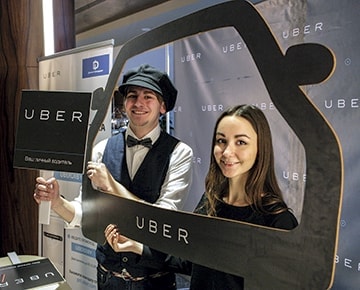Just two smartphone clicks are all that’s needed to summon a first class ride: a Mercedes, Lexus or Audi, to transport you to any location, at a modest price. The Belarusian representation of American Uber Corporation promises convenience, comfort and competitive tariffs, having recently launched in Minsk, and enjoying popularity.

At the press conference and presentation of Uber new service
However, Uber is known for having experienced misunderstandings with various nations’ legislation and authorities, so its start-up in Minsk is being viewed with speculation.
Strictly speaking, Uber isn’t offering anything new. In 2009, young programmers from St. Francisco successfully automated the task of optimising city transport movement, connecting it via mobile communication technologies. A special smartphone application can detect a passenger’s location and automatically finds the closest taxi, with evident benefits.
Taxi drivers save time, while clients receive a car promptly, with guaranteed accuracy, since time and distance are fixed by the mobile application’s automatic calculation. A detailed invoice is sent by email, with payment deducted from the client’s account, set up during registration. Drivers receive money from the servicing company, with commission charged at 24 percent.
Theoretically, everything works well, and the service is popular amongst young people who like to use gadgets. However, some issues remain unexplained, despite efforts by heads of Uber’s Belarusian representation.

Much doubt has been voiced regarding the service’s future in our country, and how taxi drivers’ may join the programme. Besides holding a taxi licence, drivers need to be registered as a company or an individual entrepreneur, and own their own car. Moreover, as Uber’s General Director in Minsk, Alexey Stakh, notes, vehicles should be no older than five years (with a future target of three years).
It is unclear how many Audi A8 or BMW X5 cars are engaged in private taxi services, but models aged five years cost around $25,000-$40,000. Of course, they also consume a lot of fuel and need expensive spare parts. Owners of such cars usually have no financial problems, and have no need to work as taxi drivers. Where will Uber find enough limousine cars in Minsk to promptly offer their services to clients within just 5-6 minutes. Covering the costs of such vehicles won’t be easy (even, impossible).
During a presentation on his concept, Mr. Stakh mentioned London as an interesting example. 18,000 local cars are serviced by Uber there, with 10,000 making over three trips monthly: a modest figure. Premium class drivers benefit once they are covering 150-200km daily, with a passenger, or making 10-15 trips daily. Will it be possible to find enough clients in Belarus to make the programme work?
Uber’s tariffs are rather high: at Br45,000 per car, in addition to $7,000 per kilometre and 1,250 per minute. To travel 15km from Minsk’s centre to a remote residential district, at an average speed of 30-40km/h, will cost around Br170-200,000: almost double that of most taxi services, which charge Br5-6,000km/h, with no additional payments. Taxi drivers suffer from low incomes but dare not increase prices, since locals are likely to stop using taxis at all if tariffs are raised. As regards speedy car arrival, Minsk faces no problem in this respect: any taxi can reach a location in 5-6 minutes (10 at the most). Accordingly, Uber is not overly prompt. In Moscow, it can take several hours for a taxi to reach a location.
In fact, fewer people than ever are using taxis, with the number of clients falling steadily over the past 2-3 years, thanks to competitively priced public transport. Buses, metro trains and city shuttles are inexpensive and quick, winning out over taxis, despite the latter’s easy accessibility. It’s questionable whether premium class cars will enjoy enough demand.
Uber’s status in Belarus remains unclear but the company asserts that it plans to act as an information resource, enabling passengers and taxi drivers to find each other. This may be true but clients pay Uber, making it important to distinguish who is responsible for the quality of services and their safety. Some states have disagreed with Uber’s position and believe that the company must admit responsibility as the carrier.
Meanwhile, another tricky element is that information will be kept on clients’ trips, with data kept by company servers. Where will these be located? And how will data be protected? Uber staff will have access to this data, so this begs the question of their reliability and honesty. It’s hard to make forecasts but it seems unlikely that the scheme will prove a hit: there are so many obstacles. It seems doubtful that Uber will be able to apply its American business model to Belarusian reality and legislation.
By Vladimir Volchkov












